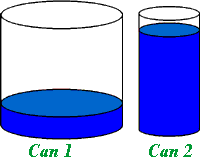 An
analogy will bring this
out more clearly :
An
analogy will bring this
out more clearly :So far, we have studied the concept of charge, how charges exert forces on each other, and how charges can generate and are influenced by electrical fields. But the basic question of how much charge can you put onto a piece of material has not yet been answered.
When a conductor is given a certain amount of charge, its potential rises. Given the amount of charge, to what potential will it be raised? This is what we mean by the capacitance of a conductor.
 An
analogy will bring this
out more clearly :
An
analogy will bring this
out more clearly :
Suppose you have a number of cans, and you pour the same fixed amount of water into them, one by one. If a can is narrow and tall, it will have a higher level of water than it would in a can which is wide. Notice that the level of water is analogous to electrical potential (in fact, it is proportional to the gravitational potential). The amount of water is analogous to the quantity of charge. Then it is clear that the level rises more easily in a can of lower capacity and less easily in a can of higher capacity.
 Just
like we can talk about capacity of cans for holding water, we can
talk about the (electrical) capacity of conductors for holding
charge. In most cases, the potential of a conductor increases
proportionally to the charge given to it.
Just
like we can talk about capacity of cans for holding water, we can
talk about the (electrical) capacity of conductors for holding
charge. In most cases, the potential of a conductor increases
proportionally to the charge given to it.
Definition:
The capacitance of a conductor, C, is the quotient of the charge Q given to the conductor to the potential V to which it is raised.
|
|
|
|
|
|
|
|
Units and Dimensions:
Clearly, the dimension of C is
|
|
|
|
|
|
|
|
|
|||
|
|
|
The unit is Coulomb/Volt, which is called a Farad, F, in honor of Michael Faraday (1791-1867). The Farad is a very large unit, and as a consequence, one often sees circuits with capacitors in the pF to µF range. The capacitor in the picture here, for example has a capacity of 470 pF.
© MultiMedia Physics 2000